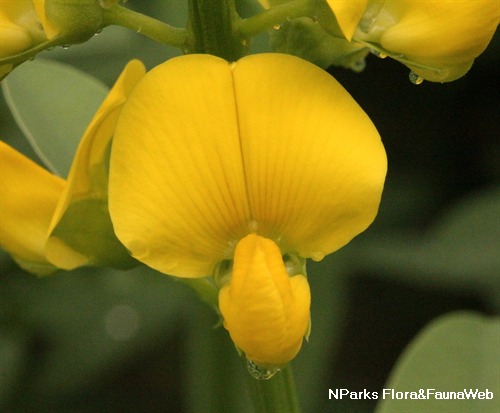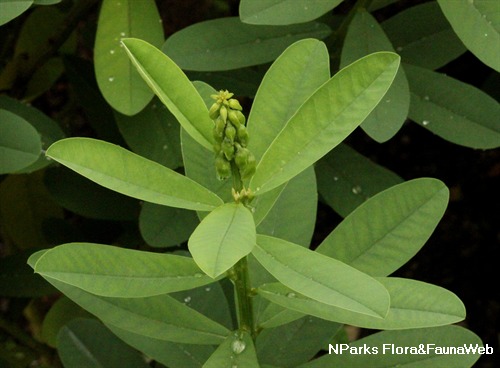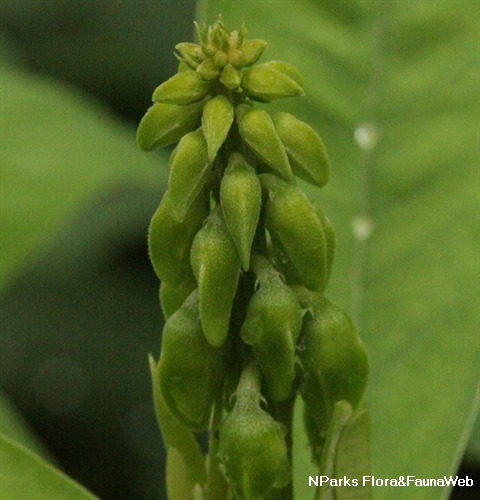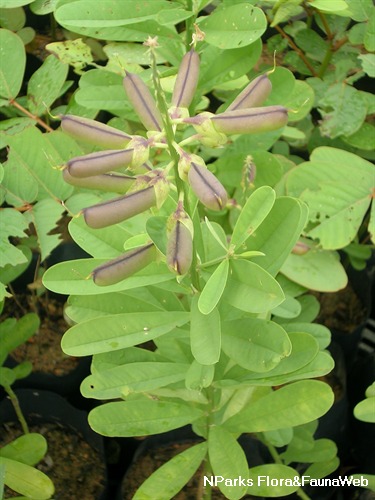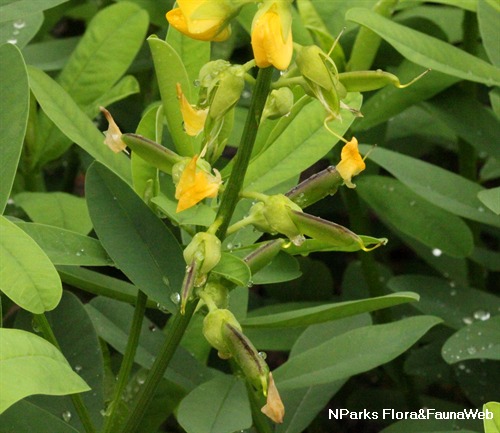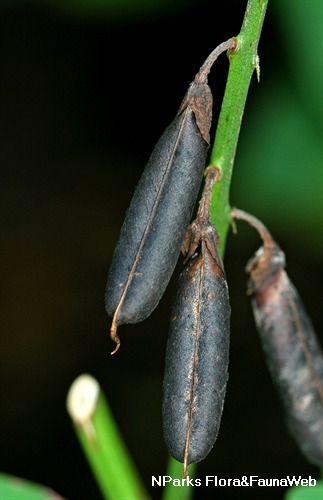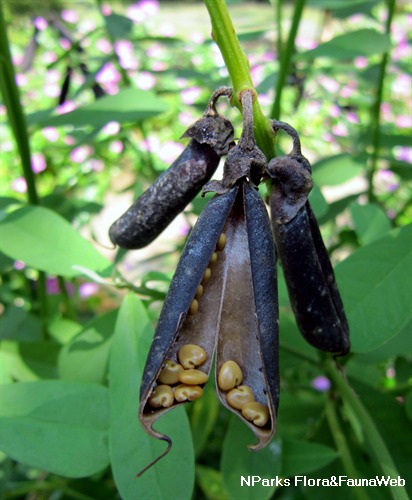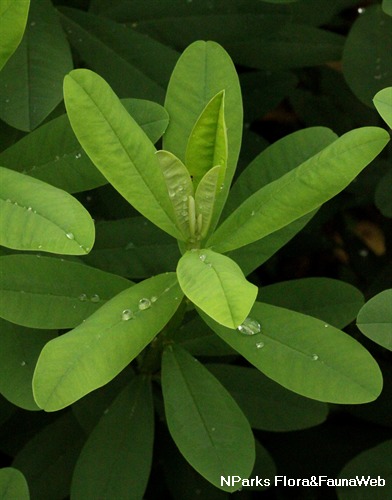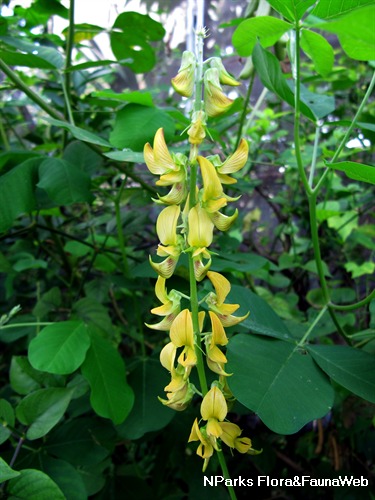
Back
Crotalaria retusa L.
| Family Name: | Fabaceae (Leguminosae) |
| Synonyms: | Crotalaria tunguensis |
| Common Name: | Rattleweed, Shak-Shak, Rattlebox, Wedge-leaf Rattlebox, 吊裙草, 凹叶野百合, 洛苛草 |
Name
Classifications and Characteristics
| Plant Division | Angiosperms (Flowering Seed Plants) (Dicotyledon) |
|---|---|
| Plant Growth Form | Herbaceous Plant |
| Lifespan (in Singapore) | Annual |
| Mode of Nutrition | Autotrophic |
| Maximum Height | 1 m to 2 m |
Biogeography
| Native Distribution | Africa, Pantropical |
|---|---|
| Native Habitat | Terrestrial |
| Preferred Climate Zone | Tropical |
| Local Conservation Status | Cryptogenic |
Description and Ethnobotany
| Growth Form | Herbaceous plant with erect growth habit, can grow up to 1.2 - 1.5 m tall. |
|---|---|
| Foliage | Simple leaves, obovate, having a rounded leaf tip and a wedge-shaped leaf base (3.3 - 9.2 cm long, 1 - 3.8 cm wide). They are sessile, spirally arranged and have an entire leaf margin. |
| Stems | Stem is ridged and velvety with short hairs. |
| Flowers | Bright yellow flower consists of 1 large triangular petal hanging over 2 smaller petals that are curled upwards like a hook (1.7 - 2.4 cm long). Flowers are arranged in terminal spike inflorescences located at the branch tips (27 cm long). |
| Fruit | Dry, hairless, cylindrical fruit is known as a pod (3 - 4 cm long). Pod colour changes from greenish to dark brown to black when mature. Shaking a mature pod produces a rattle sound, because the seeds get loose inside. |
| Habitat | Occurs along seashores and dry coastal areas. |
| Cultivation | This species should be planted in fertile, well-draining soil. |
Landscaping Features
| Landscaping | This species is planted for its bright yellow flowers. The spirally arranged leaves around an erect stem produces an attractive, symmetrical form. It can be used as a hedge or screen. |
|---|---|
| Desirable Plant Features | Ornamental Flowers |
| Landscape Uses | Parks & Gardens |
Fauna, Pollination and Dispersal
| Fauna Pollination Dispersal Associated Fauna | Butterfly Host Plant (Associated with: Lampides boeticus (Linnaeus, 1767)), Bee-Attracting |
|---|---|
| Pollination Method(s) | Biotic (Fauna) (Insects (Butterfly, Moth)) |
Plant Care and Propagation
| Light Preference | Full Sun |
|---|---|
| Water Preference | Moderate Water |
| Plant Growth Rate | Fast |
| Rootzone Tolerance | Moist Soils, Well-Drained Soils |
| Propagation Method Remarks | Propagate by seed or stem cuttings. Seeds should be collected from mature pods that were allowed to dry on the plant. Sow seeds immediately, because they quickly lose viability. |
Foliar
| Mature Foliage Colour(s) | Green |
|---|---|
| Foliar Type | Simple / Unifoliate |
| Foliar Attachment to Stem | Sessile |
| Foliar Margin | Entire |
| Leaf Area Index (LAI) for Green Plot Ratio | 4.5 (Shrub & Groundcover - Dicot) |
Floral (Angiosperm)
| Flower & Plant Sexuality | Bisexual Flowers |
| Flower Colour(s) | Yellow / Golden |
|---|---|
| Flower Grouping | Cluster / Inflorescence |
| Flower Symmetry | Bilateral |
| Inflorescence Type | Spike |
Fruit, Seed and Spore
| Mature Fruit Colour(s) | Black |
|---|---|
| Fruit Classification | Simple Fruit |
| Fruit Type | Dehiscent Dry Fruit , Legume / Pod |
| Mature Seed Colour(s) | Brown |
| Mature Seed Texture(s) | Smooth |
| Seed Quantity Per Fruit | Numerous (>20) |
Image Repository
Others
| Master ID | 596 |
|---|---|
| Species ID | 1891 |
| Flora Disclaimer | The information in this website has been compiled from reliable sources, such as reference works on medicinal plants. It is not a substitute for medical advice or treatment and NParks does not purport to provide any medical advice. Readers should always consult his/her physician before using or consuming a plant for medicinal purposes. |



